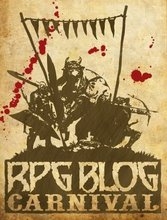
I've been digging on Dark Heresy lately, and a recent browse through the Fantasy Flight Games forums yielded this gem of a thread. The original poster asked what hive cities -- the ubiquitous urban megalopolises in the Warhammer 40,000 universe -- actually look like. The responses were amusing, along the lines of "Imagine New York City with a roof over it, with Los Angeles stacked on top of it, followed by Tokyo, Houston and so on for about 30 miles straight up."
Eventually a commenter named Jephkay posted a quick list of interesting features that can be found in these huge, ancient, decaying structures. Other forumites chimed in with their own ideas, adding to the list and no doubt firing the imagination of every Dark Heresy GM who stumbled across the thread. Here's a quick taste from Jephkay's original post:
Tactical Thinking in the Hive
I try to convey the multi-layered nature of Hives by making sure my players are aware of stairways. I'm constantly mentioning balconies, overlooks, bridges, gantries, catwalks, ducts, railways, sewage pipes, effluaries (not a real word, BTW, I made it up to describe the rivers of sludge that move waste around the underhive). They face attacks from all directions in a hive. Clever enemies will encircle the intruders, attacking from several angles at once. And there is always cover available!Gates
There are also massive gates that close off various portions of the hive. These are most common at the spire/hive interface, but even then, there must be a few hidden ways up into the nicer areas. Also, I imagine some areas are off limits for other reasons, or once were, and the gates have been repurposed. Perhaps, a thousand years ago, there was a reason for a certain gate to close and lock for 12 hours at a time, but that's been forgotten, now there is a lockdown imposed on an area. No one knows where the cogitator is that controls the gate, so the dome in question has adapted to their imposed lifestyle. Perhaps they are unaware that no one else has such a limitation. These gates were intended to hold off armies, no force the Acolytes can muster can break through them.Bridges
I can also see massive bridges across great chasms between building blocks. The bridges themselves have buildings on them. The folks on either side of the hab-canyons occasionally get riled at one another for reasons known only to them. Every once in a while, a krak missile is launched across the void to avenge some slight. It escalates, and the bridge areas become warzones. Certainly, they can't take too much of this, and might eventually fall into the abyss between hab-zones. Of course, that's where the Acolytes have to go to collect some important scrap of information, just as a hab-war breaks out over breakfast...Effluaries
Being a made up word, it should have made up rules. Perhaps falling into one counts as taking a toxic hit. 1d10 wounds, no armor or TB allowed? Drink up!










